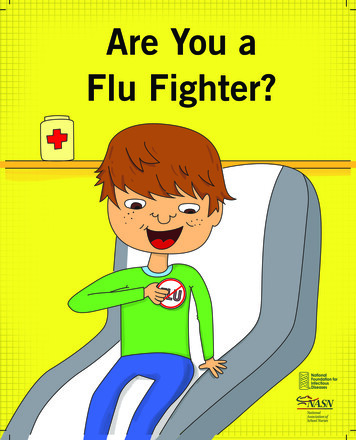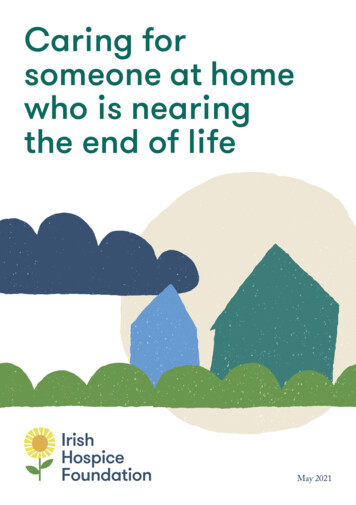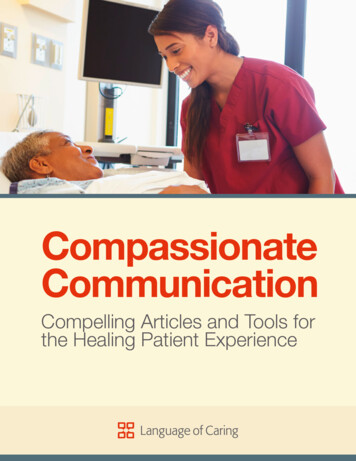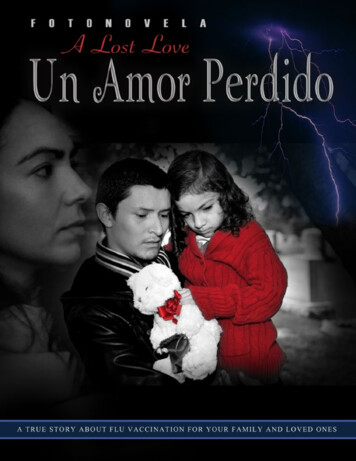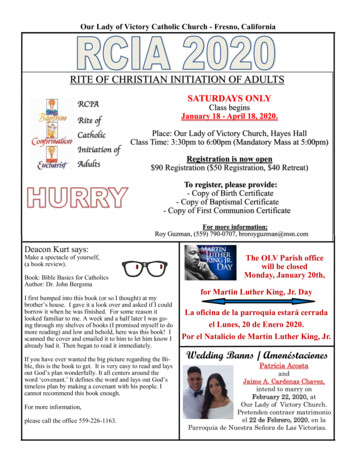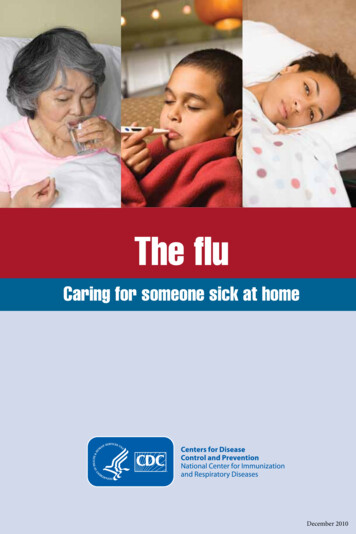
Transcription
The fluCaring for someone sick at homeDecember 2010
The flu can affectalmost everyoneWill you know what to do if someonein your house gets the flu?Read this booklet to learn how to care for someone withinfluenza (the flu).For more informationwww.cdc.gov/flu or www.flu.govOr, call 1-800-CDC-INFO (1-800-232-4636)Services in English and Spanish, 24 hours a day.
What’s inside?About the flu2Flu germs are spread from person to person3The flu may be more serious for some4Know the signs and symptoms of flu5Make a separate sick room, if you can7Tips to prevent fluid loss (dehydration)12Medicine safety16About fever18About coughs19Treat other flu symptoms20 1
About the fluInfluenza (the flu) is a contagious respiratory illnesscaused by influenza viruses. It can cause mild to severeillness, and at times can lead to death. Some people,such as older people, young children, and people withcertain health conditions, are at high risk for serious flucomplications. The best way to prevent the flu is bygetting vaccinated each year.5 steps to take if you get the flu1Stay at home and rest.2Avoid close contact with well people in yourhouse so you won’t make them sick.3Drink plenty of water and other clear liquidsto prevent fluid loss (dehydration).4Treat fever and cough with medicinesyou can buy at the store.5If you get very sick or are pregnant or have amedical condition that puts you at higher risk offlu complications (like asthma.), call your doctor.You might need antiviral medicine to treat flu.2 About the flu
Flu germs are spreadfrom person to personMost experts think that flu viruses are spread mainlyby droplets made when people with flu cough, sneezeor talk. These droplets can land in the mouths or nosesof people who are nearby or possibly be inhaled intothe lungs.Less often a person might also get flu by touching asurface or object that has flu virus on it and thentouching their own mouth or nose.How to keep yourself and othershealthy during flu season Take time to get a flu vaccine. Cover your nose and mouth with a tissue when youcough or sneeze. Throw the tissue in the trash afteryou use it. Wash your hands often with soap and water. If soapand water are not available, use an alcohol-basedhand rub. Avoid touching your eyes, nose and mouth. Germsspread this way. Try to avoid close contact with sick people. Take flu antiviral drugs if your doctor prescribesthem.Flu germs are spread from person to person 3
The flu may be more seriousfor someMost people have been able to recover at home fromflu without needing medical care. However, the flu canbe more serious for some people.People at high risk for developing flu-relatedcomplications include: Children young than 5, but especially childrenyounger than 2 years old Adults 65 years and older Pregnant women Also, during the 2009 H1N1 pandemic, AmericanIndians and Alaskan Natives seemed to be at higherrisk of flu complications People with medical conditions including:- Asthma- Neurological and neurodevelopmental conditions [including disorders of the brain, spinal cord, peripheral nerve, andmuscle such as cerebral palsy, epilepsy (seizure disorders),stroke, intellectual disability (mental retardation), moderateto severe developmental delay, muscular dystrophy, or spinalcord injury]- Chronic lung disease (such as chronic obstructive pulmonarydisease [COPD] and cystic fibrosis)- Heart disease (such as congenital heart disease, congestiveheart failure and coronary artery disease)- Blood disorders (such as sickle cell disease)- Endocrine disorders (such as diabetes mellitus)- Kidney disorders- Liver disorders- Metabolic disorders (such as inherited metabolic disordersand mitochondrial disorders)- Weakened immune system due to disease or medication (suchas people with HIV or AIDS, or cancer, or those on chronicsteroids)- People younger than 19 years of age who are receiving longterm aspirin therapy- People who are morbidly obese (Body Mass Index, or BMI, of40 or greater)4 The flu can be serious for some
Know the symptoms of fluFlu symptomsPeople who have the flu often have some or allof these symptoms: Fever* or feeling feverish/chills Cough Sore throat Runny or stuffy nose Muscle or body aches Headaches Fatigue (tiredness) Some people may have vomiting and diarrhea,though this is more common in childrenthan adults.* It’s important to note that not everyone with flu willhave a fever.How long should people with the flustay at home?People with flu-like illness should stay at homeexcept to get medical care or other necessities: Until at least 24 hours after they are freeof a fever without having taken any medicinesthat lower fever. Examples of medicines thatlower fever include acetaminophen (suchas Tylenol ) and ibuprofen (such as Advil or Motrin ).When you see a mark after a product in this brochureit is only meant as an example of a brand-name drug. Itdoesn’t mean the U.S. government or CDC is endorsingor recommending that certain product.Know the symptoms 5
Know the emergencywarning signsThere are “emergency warning signs” thatshould signal anyone to seek medical care urgently.Seek care if the sick person has ANY of the signs below.In children, emergency warning signs that needurgent medical attention include: Fast breathing or trouble breathing Bluish skin color Not drinking enough fluids Not waking up or not interacting Being so irritable that the child does not want tobe held Flu-like symptoms improve but then return withfever and worse cough Fever with a rashIn addition to the signs above, get medical helpright away for any infant who has any of thesesigns: Being unable to eat Has trouble breathing Has no tears when crying Significantly fewer wet diapers than normalIn adults, emergency warning signs that needurgent medical attention include: Difficulty breathing or shortness of breath Pain or pressure in the chest or abdomen Sudden dizziness Confusion Severe or persistent vomiting Flu–like symptoms that improve but then returnwith fever and worse cough6 Emergency warning signs
Make a separate sick room,if you canKeeping the person with flu in a separate sick roomcan help keep others in the family from getting the flu.Take these steps to create a separatesick room: Try to give the sick person their own room.If there is more than one sick person, they canshare the sick room if needed. If you have more than one bathroom, have sickpeople use one bathroom and well people use theother one. Give each sick person their own drinking glass,washcloth, and towel.Make a separate sick room 7
Have these items in thesick roomq Tissuesq Trash can with lid and lined with a plastic trash bagq Alcohol-based hand rubq Cooler or pitcher with ice and drinksq Cup with straw or squeeze bottle to help withdrinkingq Thermometerq Humidifier (A machine that puts tiny drops ofwater into the air. This extra moisture can make iteasier for the sick person to breathe.)q Facemasks (Sick people should wear a facemask ifavailable when they leave the sick room or arearound other people.)About medicines in the sick room Store all medicines out of reach of children. If youhave no young children in the home, placemedicines for adults in the sick room. Write down medicine dose and when dosesare needed.PURELLHANDSANITIZER8 Items for the sick room
Follow the sick room rulesProtect well family members from getting the flu. If thesick person must leave the room to go to the bathroomor to a doctor’s visit, ask them to wear a facemask. Nofacemask at home? Ask the sick person to use a tissue tocover coughs and sneezes.Follow these 4 sick room rules:1Avoid having other people enter the sick room.The sick person should not have visitors other than thecaregiver. If visitors must enter, they should stay at least6 feet away from the sick person.2Cover coughs and sneezes.Ask the sick person to cover their nose and mouth witha tissue when they cough and sneeze. Ask them to throwused tissues in the trash.3Choose one caregiver.If you can, choose only one caregiver to take care of sickfamily members. If possible, ask someone else to be thecaregiver if you are pregnant or have certain chronichealth problems. If you get the flu, it could be muchmore serious for you.4Keep the air clean.Open a window in the sick room, if possible, or use afan to keep fresh air flowing.Follow the sick room rules 9
How to clean the sick roomYou’ll want to clean the sick room each day. Followthese tips:Cleaning hard surfaces Clean surfaces that may have flu germs onthem. These may include doorknobs, bedsidetables, bathroom sinks, toilets, counters,phones, and toys.Clean these hard surfaces by using water anddish soap. Or use common household cleanersthat kill germs.Cleaning bed linens and laundry Wash bed sheets and towels with normallaundry soap and tumble dry on a hot dryersetting. Hold all dirty laundry away from yourface and body. Wash your hands right aftertouching dirty laundry. It’s OK to wash the sick person’s beddingor clothes with other people’s laundry.Cleaning dishes Wash the sick person’s dishes with normaldish soap or place in the dishwasher.10 Cleaning the sick room
Tips for caregiversWhen caring for people who have the flu: Avoid being face to face with the sick person.If possible, it is best to spend the least amountof time in close contact with a sick person. When holding sick children, place their chinon your shoulder so they will not cough inyour face. Wash your hands often and the right way.Sing the “Happy Birthday” song two times orcount slowly to 20 as you wash. If soap and water are not available, use analcohol-based hand rub. Make sure to wash your hands after touching thesick person. Wash after handling their tissuesor laundry.Tips for caregivers 11
Tips to prevent fluid loss(dehydration)Give plenty of liquids at the first sign of flu. Sickpeople with the flu need to drink extra fluidsto keep from getting dehydrated. Mild fluid losscan most often be treated at home. Yet, severedehydration is VERY serious and must be treated inthe hospital.Tips to prevent dehydration Continue to nurse or bottle feed your baby.Babies get all the fluid they need frombreastfeeding or formula.If your baby refuses to breastfeed or takeformula from the bottle, call the doctor. Yourdoctor may recommend you give your child aspecial drink like Pedialyte , which is meantto prevent dehydration. If the sick person is not eating well, encouragethem to drink liquids. Avoid alcohol or drinkswith caffeine in them such as colas, tea, andcoffee. Older adults and people with kidney problemsshould check with their doctor about safeamounts of liquid to drink when sick. Offer clear fluids such as water, broth, orsports drinks. Use a squeeze bottle or a straw for people tooweak to drink from a cup. Or offer ice chips orfrozen ice pops to suck on.12 Tips to prevent fluid loss
Check for fluid lossUse this list to check for dehydration: Make sure babies have wet diapers.Check that wet diapers are as frequent andheavy as normal. Look for tears when the baby or toddleris crying. Check to see how wet the child’s mouth is.The inside of the mouth should be wet.Wash your hands after you do this. Check to see that children, teens, and adultsare making frequent trips to the bathroom tourinate. Check the urine color. Clear or lightyellow-colored urine means the person isgetting enough fluid. Dark yellow urinesignals the person is dehydrated.Check for fluid loss 13
When to get medical helpfor fluid lossWhile anyone can become dehydrated, infants, children,and older adults are at greatest risk of getting dehydrated.Also, pregnant women will want to make sure they aregetting enough fluids.14 When to get medical help for fluid loss
When to call the doctor to ask for adviceCall right away if you or your child has any of thesesymptoms of dehydration:Signs of dehydration in infants and toddlers: Sunken soft spot on top of your infant’s head Diarrhea or vomiting in infants 2 monthsor younger The baby seems much less active or moreirritable than normal Fewer tears when crying or not making tearsSigns of dehydration in children and adults: Not making tears Less than normal amount of urine. In babiesyou may see fewer wet diapers or diapers thatweigh less than normal Skin that is dry and takes long to go back toposition when pinched Dry mouth or dry eyes Fast-beating heart Blood in the stool or blood in vomit The child has had a fever for 12 or more hoursand also is not able to drink fluids, is throwingup or having diarrhea The child may be cranky or irritable, hard towake up, have little energy, appear“rag doll weak”When to call the doctor 15
Medicine safetyTake the right amount of medicineRead labels to make sure you are taking the doselisted on the label. Call your doctor or pharmacistif you have questions. Watch that you don’t goover the daily limit (maximum dose) for certainmedicines. Never give aspirin to children age 18or under if they have the flu.Don’t drink alcohol and take medicineSome medicine labels say, “Do not mix withalcohol” or “Avoid using with alcohol.” Manyprescription and over-the-counter medicines can bedangerous or deadly when mixed with beer, wine,or liquor of any kind.Talk to your doctor if you are pregnantIf you are pregnant or think you might be pregnant,make sure you talk to your doctor before takingany medicines.16 Medicine safety
Medicine safety and childrenAbout medicines for children Store all medicines out of reach of children.Place them in a locked cabinet where childrencan’t reach them. Buy pain and fever medicines that say“children’s” on the label. Also, look for the words“acetaminophen” or “ibuprofen” on the label. Call the doctor if your child is very small orvery large for his or her age so you will besure to give the right amount of medicine.The dose you give your child depends on thechild’s age and weight. Use a special medicine spoon, dropper, or thecap that came with the medicine. Wash thecap, dropper, or spoon with soap and waterafter each use. Don’t give cough or cold medicines to childrenyounger than 4 years of age.WarningThink your child age 18 or younger might have the flu?Never give them aspirin or products with aspirin in them.Check all medicine labels to make sure they do not contain aspirin,also called salicylate. Although it mostly affects people age 18 oryounger, Reye’s Syndrome can strike anyone who takes aspirinproducts when they have the flu.Reye’s Syndrome is a rare, serious illness than can affect the blood,liver, and brain of someone who has recently had a flu virus. Thisillness can cause confusion, seizures, or coma. Talk to your child’sdoctor about signs and symptoms of Reye’s Syndrome.Medicine safety and children 17
About feverBringing down a fever will make the person feelbetter and help patients rest.Treating a fever without medicine Put a cool, damp washcloth on their forehead. Wash their arms and body with a cool cloth. Give the person a slightly warm bath.Treating a high fever with medicine Look for the ingredients “acetaminophen” or“ibuprofen” on labels. These medicines may take 30 to 45 minutesto start working. They may not bring feversdown to normal temperature.When a fever causes a seizureA seizure makes you have jerky spasms and can alsomake you pass out. In rare cases, a fever can bring ona seizure, called a “febrile seizure.” Seizures brought onby fever are more common in young children. Call thedoctor or get medical help for seizures.Any child younger than 3 months who has afever should see a doctor.18 About fever
About coughsCoughing can help clear out mucous and congestionfrom your lungs. Yet, dry coughs when there is nomucous can make your airways, throat, or chestsore. Treating a dry cough can stop this sore feelingand also help you get rest.Treating a dry cough Ask the pharmacist about which coughmedicines are best to treat a dry cough.Do not give children younger than 4 yearsof age cough or cold medicines. Set up a humidifier. That’s a machine that putstiny drops of water (moisture) into the air.This extra moisture can make it easier for thesick person to breathe. Offer adults a cough drop or hard candy to soothetheir throat and lessen the urge to cough.About coughs 19
Treat other flu symptomsTreating sore throatOffer the person: Acetaminophen or ibuprofen for the pain Ice chips or frozen ice pops to numb the throatand get fluids into the bodySome people find gargling with salt water helpssoothe a sore throat. Mix 1 cup of warm water with 1 teaspoonof salt Gargle and then spit outTreating chills, aches, and painOffer the person: A light blanket for chills Acetaminophen or ibuprofen for aches andpain. Make sure to read the label for the rightamount.20 Treat other flu symptoms
Treat other flu symptomsTreating congestionThe flu can cause the body to make more mucous.The nose, sinuses, ears, and chest can get stuffy.This congestion can cause pain.Offer the person: Acetaminophen or ibuprofen for the pain Decongestants (Talk to your pharmacistabout the kind you should buy. Do not givecough or cold medicine to children youngerthan 4 years of age.) A humidifier. That’s a machine that puts tinydrops of water (moisture) into the air. Thisextra moisture can make it easier for the sickperson to breathe. A warm washcloth on the face to easesinus painTreating stomach problemsPeople with the flu may have stomach pain.They may even throw up or have loose stools(diarrhea). Anyone with severe stomach painshould call the doctor.Offer the person: Plain foods that are easy on the stomach Clear liquids to drink Medicines to help adults treat loose stoolsTreat other flu symptoms 21
CS218813The FluCaring for someone sick at home
5 steps to take if you get the flu. Stay at home and rest. Avoid close contact with well people in your . house so you won’t make them sick. Drink plenty of water and other clear liquids . to prevent fluid loss (dehydration). Treat fever and cough with medicines . you can buy at the store. If you
